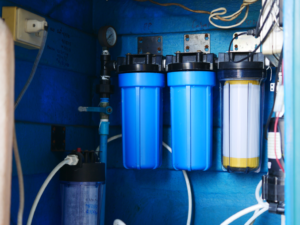
Looking to learn a little something about reverse osmosis? This LaGrange water softening company has you covered.
The History of the Reverse Osmosis System
Reverse osmosis has been a concept since the mid 18th century. During this time, French physicist Jean-Antoine Nollet demonstrated the process by creating a membrane out of a pig bladder. That said, while Nollet’s presentation proved the efficacy of reverse osmosis, it saw little use in real-world applications.
It would actually be around 200 years before reverse osmosis would see substantial use in the real world. In 1949, after some grand experimentation, UCLA scientists discovered that reverse osmosis could be used in the desalination of water.
From there, the concept grew rapidly. Within 20 years, reverse osmosis systems were being used for both the large-scale desalination of ocean water and the small-scale purification of municipal water.
Today’s reverse osmosis systems are adept at filtering out contaminants within water. As such, when trying to obtain 100% pure drinking water, they’re the filtration systems to turn to.
How Do Reverse Osmosis Systems Work?
Reverse osmosis systems are, by and large, simple devices. They consist of between 3 and 5 filters. Each of these filters facilitates different responsibilities, filtering water more and more as it passes through the system.
Whereas the pre-filter removes big contaminants such as dirt and sand, the semipermeable membrane and post-filters remove small contaminants such as calcium, magnesium, manganese, iron, and arsenic.
Though reverse osmosis systems can’t remove all of the contaminants within a water supply, they can come very close. The contaminants left over after the completion of reverse osmosis purification are negligible and have little effect on the water’s quality.
The Benefits of Reverse Osmosis Systems
There are a number of benefits that come with installing a reverse osmosis system. Reverse osmosis systems are beneficial in that they:
Purify Water as Much as Technologically Possible
As was noted above, reverse osmosis systems purify water to the greatest extent currently possible. Removing everything from minerals, to bacteria, to chemicals, and more, they produce water that is highly smooth and drinkable.
Some of the contaminants that are removed by reverse osmosis systems include arsenic, lead, iron, calcium, magnesium, manganese, and E. coli. In removing these contaminants, reverse osmosis systems not only improve the quality of water, but the safety of water as well.
Utilize Very Little Energy
Another benefit of reverse osmosis systems is that they use only small amounts of energy in order to operate. This is due to the fact that they’re water pressure-driven devices.
As such, they cost almost nothing to run. Once you’ve paid for the system and its installation, the only other costs you’ll have to pay are maintenance costs.
Take Up Very Little Space
You might be under the impression that a reverse osmosis system is a large device. As far as water purification systems go, it’s the exact opposite. In fact, reverse osmosis systems are actually quite small.
In many cases, they can be installed directly under kitchen sinks. You won’t have to worry about your system taking up a lot of space. Once it’s installed, you’ll barely notice it.
In Need of a LaGrange Water Softening Company
Are you interested in installing a reverse osmosis system? In need of a LaGrange water conditioning company? DuPage Water Conditioning is the company to call.
We’ve installed reverse osmosis systems in countless LaGrange area properties. Regardless of your reverse osmosis needs, we have you covered.
Contact us now to schedule an appointment!
